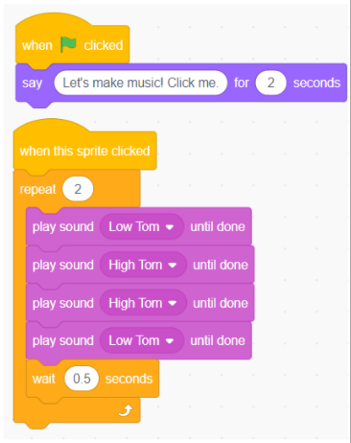Code a Drum in Scratch


Learners develop decomposition skills and learn about sequences and repetition by using Scratch to code a drumming sequence.
Safety Notes
Ensure you are familiar with Let's Talk Science's precautions with respect to safe delivery of outreach to youth.
What To Do
- Learners can work independently, or in groups of two to three. Ask educator to group learners, if applicable.
- Learners access the website Scratch to create an account. Visit the Scratch Tips Guide to teach learners how to do this.
Drums Activity: Code Overview |
|
|---|---|

|
This is the complete code for the Scratch Drums Activity. Each block is explained in the "Code Explained" section below. View the completed Scratch Program here: |
- Once an account has been created, learners code as drum as follows above.
- Encourage learners to remix their code, as follows:
- Sequence the drum sounds to create an ABAB (LOW-HIGH-LOW-HIGH) pattern.
- Sequence the drum sounds to recreate a song or tune.
Discovery
By creating a drum using Scratch, learners use decomposition skills and learn about sequences and repetition. Decomposition is the ability to break down a problem (making the drum) into smaller parts or sub-problems (the code), to reduce the overall complexity of the problem. Sequences involve tasks which are repeated and/or only occur under certain conditions. The steps in an algorithm always follow a sequence. Simple, linear sequencing is one of the first concepts learned when coding, which learners achieve through completing this activity! Learners also further develop critical thinking, testing and evaluation skills through this activity.
As technology advances, it is more important than ever that people contribute to the digital world. Building computational thinking skills, critical thinking, decomposition, pattern recognition, testing and evaluating skills, better prepare learners for the real and the digital world. Being able to think critically is an important skill to have that helps learners become constructive citizens and interact with the world in meaningful ways
- There are lots of fun activity ideas on the Scratch website for learners to try next; visit the site to find inspiration!
- Visit this tutorial to make music.
Appendix A: Drum Code Explanation
What's Happening?
By creating a drum using Scratch, learners use decomposition skills and learn about sequences and repetition. Decomposition is the ability to break down a problem (making the drum) into smaller parts or sub-problems (the code), to reduce the overall complexity of the problem. Sequences involve tasks which are repeated and/or only occur under certain conditions. The steps in an algorithm always follow a sequence. Simple, linear sequencing is one of the first concepts learned when coding, which learners achieve through completing this activity! Learners also further develop critical thinking, testing and evaluation skills through this activity.
Why Does it Matter?
As technology advances, it is more important than ever that people contribute to the digital world. Building computational thinking skills, critical thinking, decomposition, pattern recognition, testing and evaluating skills, better prepare learners for the real and the digital world. Being able to think critically is an important skill to have that helps learners become constructive citizens and interact with the world in meaningful ways
Investigate Further
- There are lots of fun activity ideas on the Scratch website for learners to try next; visit the site to find inspiration!
- Visit this tutorial to make music.
Appendix A: Drum Code Explanation